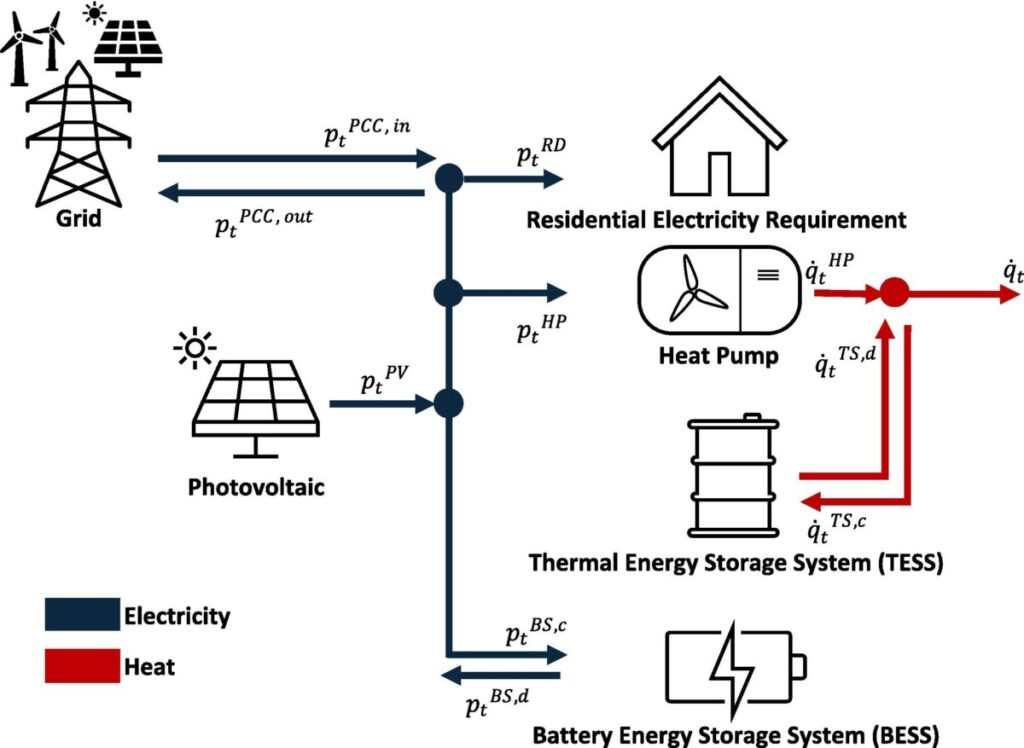Researchers have used linear programming-based multi-objective optimization to optimize 30,912 unique scenarios that show heat pumps that work in combination with PV power. The optimization modeling was carried out under the conditions of the market prices of the day.
A group of scientists led by researchers from the Austrian Technical University of Leoben has developed a linear programming (MILP) on Mixed-Integer, on multi-objective optimization (MOO) for flexible heat pump in households.
30,912 Unique scenarios were tested by the researchers and at the same time optimized to minimize the energy costs of households and to alleviate the voltage on the low -voltage schedule by optimizing the degree of self -supply.
“Insofar as we know, no research has fully integrated these objectives within a MILP-based Moo-Framework at individual household level,” said the corresponding author Christopher Gradwohl PV -Magazine. “This study is investigating the theoretical potential of flexible heat pump operation for heating in decentralized energy systems as a means to improve the integration of renewable energy and to reduce local grid loads based on a variety of pre -defined synthetic energy -saving profile.”
The Milp-MOO model was used in Python. “MILP was selected for the optimization framework because worldwide optimality guarantees by structuring the problem within a well -defined mathematical model. MILP seamlessly integrates with demand response programs and renewable energy reasons, making it a very effective tool for cost -minimization and operational efficiency.
In the modeling, the scientists have inserted six living conditions, good for single -family homes or apartments in buildings, rented or owned, and one or two people per household. They were crossed with four building types, good for varying thermal energy -requirements based on the age of the buildings and corresponding heating efficient levels.
Image: Montanuniversität Leoben, Energy Conversion and Management, CC by 4.0
“Subsequently, to record a wide range of potential results, variations in important parameters were used to every scenario,” the researchers said. “These parameters include PV system size (0-10 kW), storage capacities of electrical energy (0, 3, 5 and 10 kWh), thermal energy storage capacities (0, 200, 500 and 1,000 l), heat pump type (air source or geotherm) and the source temperature of the heating system.”
The optimization was used under day -to -day spot market prices as the primary demand response signal. The city of Leoben, located in Central Austria, was used as the site for radiation data, with a global radiation level of approximately 1,200 kWh/m2/a. The simulation also integrated a system loss factor of 10%, an optimal tilt angle of 35 ° and a south -facing Azimut. The supposed efficiency for the air source of the air source was 0.4 and 0.35 was the assumed efficiency for the geothermal heat pump.
“Our objective for the objective for one costs, balanced purposes to minimize the competitive goals to minimize energy costs and to maximize the degree of self-supply. In particular, the framework uses Volatile Dag-Ahead Energy Prizes as an implicit demand response signal, resulting in an improved use of PV generation and increased household.
The analysis showed significant reductions in local peak roselastings-zowel import as an export-driven driven by heat pump, energy storage use and price-based demand response. Configurations with only thermal energy storage and heat pumps were found to be very effective when achieving increased degrees of self-supply, which is better than the better performance of combined battery and thermal storage configurations with retention of relatively lower total costs.
The model was presented in “Unlock flexibility of the heat pump: a multi-objective optimization approach for self-supply and energy costs“Published in Energy conversion and management. Researchers from the Technical University of Austria of Leoben and the Deakin University of Australia participated in the research.
This content is protected by copyright and may not be reused. If you want to work with us and reuse part of our content, please contact: editors@pv-magazine.com.
Popular content


